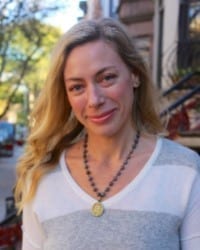Abbie Galvin is the founder of The Studio, a dedicated space for Katonah yoga. The former filmmaker and psychoanalytical enthusiast has drawn parallels between film, psychology, and yoga as a way of seeing, with a similar end goal of becoming a well-adjusted individual. She describes yoga as not just cultivating awareness, but gathering insight as to how to develop potential. Abbie believes that having an idea beyond personal frame of reference is how we develop insight and self-awareness.
It takes a competent mind and stable body to open to perspective that goes beyond our default mode of unconscious patterning. Katonah yoga describes the human condition as having three natures, the first being our karmic inheritances. Our second nature includes the techniques we learn in our lifetime to educate the mind and expand consciousness. The third nature, or stellar nature, is connection to the true self. Though Katonah yoga is not described as a devotional practice, Abbie will attest that a practitioner can still have a spiritual experience; that the key to transcending habitual nature lies in unlocking the imagination.
We recently caught up with Abbie to learn more about what it means to cultivate spiritual intelligence through the lens of sacred geometry and the art of repetition. Learn from her IRL at Wanderlust Stratton this June! For tickets and more information, click here.
Wanderlust (WL): In your first Katonah yoga class, you had what you described as a chemical reaction—how was that different from other reactions or responses we might have in a typical yoga class?
Abbie Galvin (AG): What I experiences was that I could embody an idea in my body instead of just having a physical sensation. I really saw that this work would change my interior instead of just giving me a physical practice.
WL: How do you know your interior has changed if you can’t see it?
AG: My body changed. I could feel more spacious, more energy moving through it—I never felt that before, I had just felt the arduous of working hard because I have the ability to do that. This physical practice was really a conversation between my conscious and my unconscious self, instead of just exerting physical effort to do what the teacher was telling me to do. In our classes we really teach asana, we don’t just call out poses, which is totally different because then people learn how to fit themselves instead of just how to function in the room and survive.
WL: How is Katonah yoga philosophy rooted in Taoism?
AG: It’s one of the trinities of how to explore that yin and yang is mediated by you, and that nature has pattern—the pattern of the seasons, the pattern of your period, the pattern in a leaf or in wood—and we are all part of that; it’s how we witness intelligence. The more you repeat a pattern, the more you develop the capacity to have insight. The more you repeat anything is how you get good at things. The more you repeat pattern with good form, the more you develop your potential to change and to grow and have insight and realizations and revelations. That’s how people evolve.
WL: What happens in practice when a pattern is expected?
AG: Pattern is very conscious—it has to be, otherwise it’s unconscious pattern and after a while people get hurt. That’s why I’m not a big fan of just calling out and cuing poses. We can talk about transformation all we want, but it’s not happening if all people do is listen to a cue and are either doing their version or trying their best. But we’re not interested in your best, we’re interested in how you measure up, which is very different than your best—and its probably better than your best because it has some real information in it, and it’s not just an emotional effort to try hard or please the teacher or stretch themselves.

Photo by Bia Andrade
WL: By measuring up do you mean using discernment?
AG: Well not just any discernment, but to use poses the way they’re designed. We use the idea of origami folding and your joint space. You’ve got 12 major joints, and folding in joint space is like an origami fold. In origami when the corners don’t meet there’s an issue, so when you actually put your knee in your armpit which is a real fit, or your chest on your thigh which is a real fit, your kidney becomes available. And then you’ve got a fold with interior information that’s available within the fold. So you’re in the fold of personal integrity.
WL: But obviously bodies are very different from a piece of paper, right?
AG: That’s right. Bodies are three-dimensional and paper is two-dimensional. We are three-dimensional, so we work with the idea of geometry because it has dimension, it has volume and we want people to know they’re not linear, they’re spherical. Because we don’t live in the middle of a line we live in the middle of a sphere. So we are spherical beings. So when we teach physical practice we teach people to fold and unfold, but we also teach people to be spherical so that when you twist you don’t just squish right and left, you revolve around a plum line, a spit which gives you dimension to open up a field of vision. It’s to flush one kidney and open up the opposite lung, it serves a very pragmatic purpose so that poses become tools.
WL: How do you know that flushing a kidney can open a lung?
AG: Let’s look at a plow. If you put your legs over your head and put your knees right in your armpits or you put your knees next to your ear, in Chinese philosophy your ears are your kidneys, they are the same size and shape as your kidney. A knee is also a kidney, so if you put your knees next to your ears your kidney is fully open. So your job in a plow is to pack those kidneys with air. That way your back is also available and more pliant instead of a hard shell so that it doesn’t overwhelm your potential, which is your front body. And then you’re round like a sphere. Because the back is like the mineralization of your age and it gets harder and harder as you get older and older, we want to keep its pliancy, which is why a plow pose is a real longevity pose.
WL: Is Katonah yoga an evolution of the old yoga model?
AG: We’re not doing it to be innovative, but to be functional. We look at all the people with injuries, diseases, and issues that can be addressed by working from the outside in, and then we get to see how people organize themselves differently. It’s being able to allow someone to let go of the investment and look at how they’re doing something to have an experience and insight. That’s where awareness and change come in, you try to alter someone’s frame of reference to teach them something that’s much more efficient and effective than the habit they have or the prepensely scope they have, which is not sustainable.
None of this is arbitrary—it is all for function and is very pragmatic but also quite magical. The old model was appropriate for their time and maybe their student body, but Iyengar came from a very messy culture, which is why his practices are very rigid. Other practices where they talk about opening up the heart, for our students, most people’s hearts in this culture are already more than open. They’re too vulnerable! We want to teach people how to have a good boundary, not to open their hearts. The heart is a pump and you don’t open a pump. You give it space to function well. Our practice is not an emotional practice, that’s for therapy and we’re not medical.
WL: Right, we’re not therapists. But a lot of people come to yoga seeking it as a form of self-help.
AG: If you stay formal and have good technique you will inevitably have an emotional experience of joy. If you want to do good yoga you’re going to need a good technique. We are very technique-oriented because that gives students a lot of new experiences, both emotional and physical, which gives them great pleasure. If you have lots of good techniques, you will have more metaphors to play with, you will become more metta. When you crosshatch yourself you can weave together a beautiful tapestry of your life.
WL: What do you wish that more yoga practitioners knew?
AG: That the world is round, that they are round, that there are so many possibilities for potentiating oneself and that everybody should use their practice well—that they should do what they do and do it with intelligence and imagination. I’d want them to know that this world is amazing and that being in a body is a gift and there is so much potential and love in it all.
—
 Andrea Rice is a writer, yoga and meditation teacher, and Wanderlust Festival presenter. Her articles and essays have appeared in The New York Times, Yoga Journal, The Wanderlust Journal, NY Yoga + Life, mindbodygreen, and SONIMA, among other publications. She has been teaching yoga since 2010, first in Brooklyn and Manhattan, and now in Raleigh, NC, where she currently resides. She is also co-authoring a book about the application of seasonal rhythms and yoga philosophy to modern life, which will be published by New Harbinger in early 2020. Connect with Andrea on Facebook, Instagram, and Twitter, and sign up for her quarterly newsletters on her website: www.andreariceyoga.com.
Andrea Rice is a writer, yoga and meditation teacher, and Wanderlust Festival presenter. Her articles and essays have appeared in The New York Times, Yoga Journal, The Wanderlust Journal, NY Yoga + Life, mindbodygreen, and SONIMA, among other publications. She has been teaching yoga since 2010, first in Brooklyn and Manhattan, and now in Raleigh, NC, where she currently resides. She is also co-authoring a book about the application of seasonal rhythms and yoga philosophy to modern life, which will be published by New Harbinger in early 2020. Connect with Andrea on Facebook, Instagram, and Twitter, and sign up for her quarterly newsletters on her website: www.andreariceyoga.com.
1
The post Your Body is Sacred Geometry. Abbie Galvin Explains Why It Matters appeared first on Wanderlust.
from Wanderlust https://ift.tt/2NeS0cA
via IFTTT




No comments: